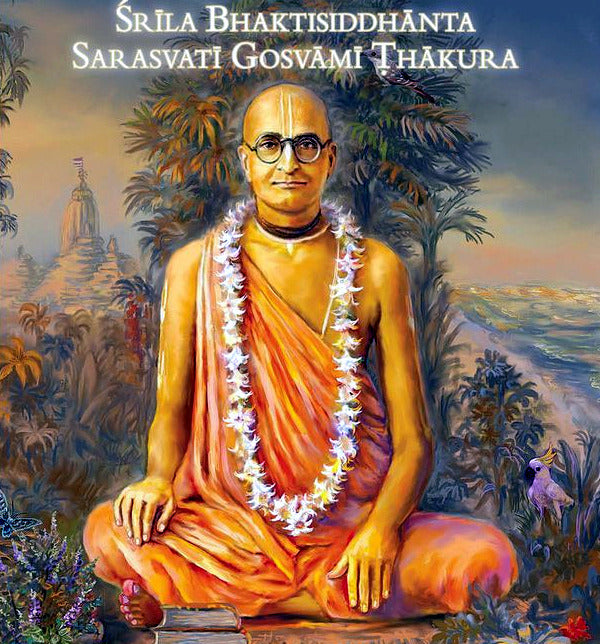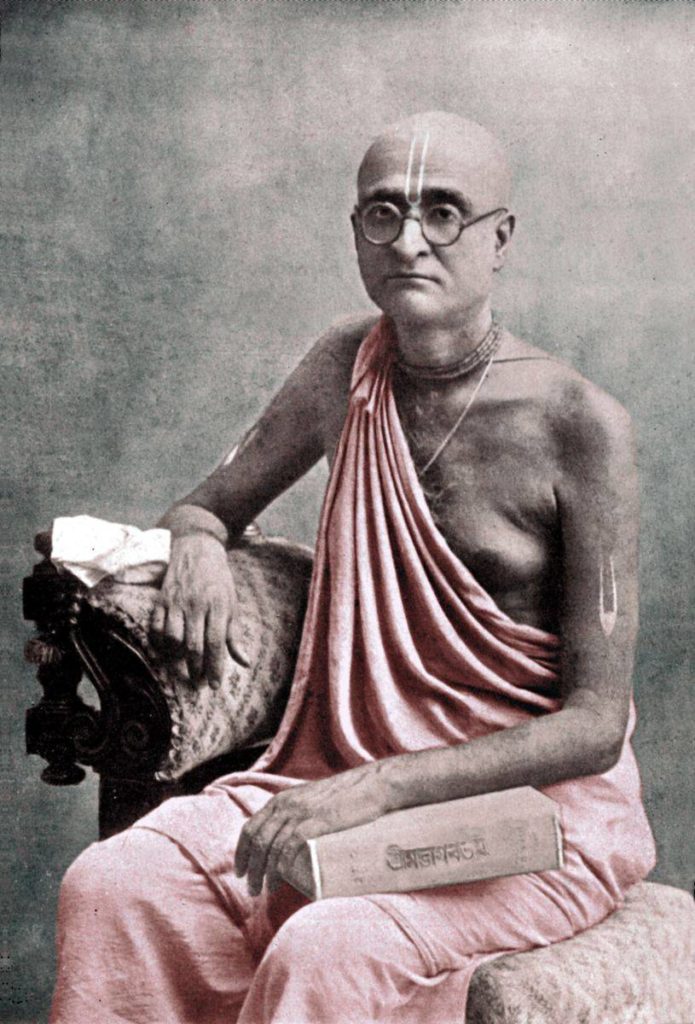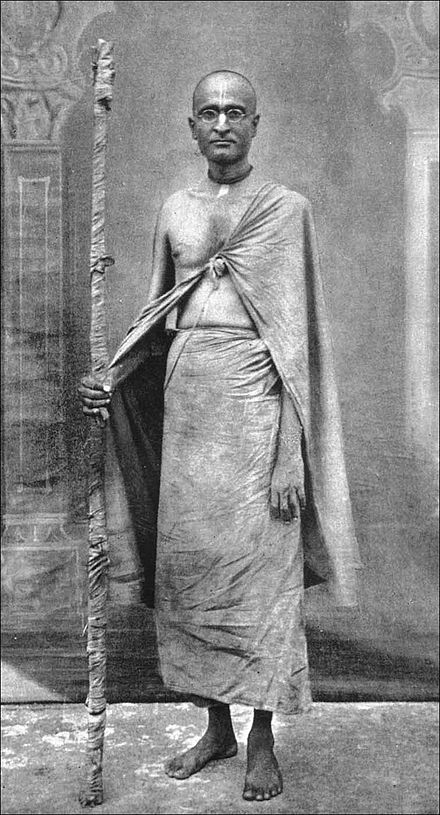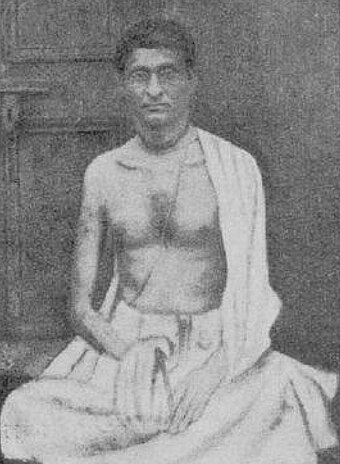
The real significance of the word nama-yajnaThe word yajna is derived from the root yajby adding the suffix na which means to worship, to adore, to honor and to respect. Hence the word nama-yajna means by taking a vow of offering full respect and adoration towards nama for completing specific numbers as a principle.This nama, the one and only mantra, consisting of sixteen (16) namas and thirty two (32) syllables has been instructed by Sri Krishna Chaitanya Mahaprabhu, the Absolute Redeemer and Saviour in Kali-yuga.
hare krsna hare krsna krsna krsna hare hare|hare rama hare rama rama rama hare hare
Meditating and chanting this harinama mahamantra with full concentration while sitting in a fixed place and completing fixed rounds is called nama-yajna.The method of following this nama-yajna consisting of one hundred crores of namas upon taking the vow:To perform this ritual, one needs to place the Sri vigraha of Bhagavan or the objects related to Supreme God (ganga jal, tulasi, Srimad Bhagavatam etc.) as witness with firm conviction in front of him and take vow with vedic chants. And according to that vow, one should give up all other work to be able to fully concentrate on harinam until the specific number of chanting according to his vow is completed.The special rule of this vrata is not to accept any seva from others, honoring the remnants

after offering the bhoga prepared by himself to the Lord and not engaging in idle talks with anyone.Srila Prabhupada’s vow to chant hundred crores of nama or Shata-koti nama-yajna upon observing the Vrata Since 1905, Srila Bhaktisiddhanta Saraswati Goswami Prabhupada chose the most solitary place in the house of Sri Chandrashekhara Acharya, situated in Sridham Mayapur to fulfill his vow to chant shata koti harinam. According to his vow he completed three lakhs of nama daily with staunch renunciation in adherence to Srila Thakura Haridasa. To complete this vrata with such determination took him almost ten long years. Everyday he used to chant 64 rounds of japa beads, 3 times a day, which means 192 times of japa altogether in counts.During the performance of this ritual, there were no other mathas or temples or any other houses or inhabitants. Sridham Mayapur was nothing but a dense forest at that time. Only at Yogapith, Sri Gaura Vishnupriya’s deities established by Srila Bhakti Vinod Thakur used to be worshiped.Srila Prabhupada firmly wanted to perform his vow of japa ritual staying at Sridham Mayapur only. He used to live in a small hut or kutir at Vrajapattan. During the rainy season water used to drip or pour through the roof shaft. He used to hold an umbrella to protect his head and continued with japa. During this ritual, Srila Prabhupada kept his own worshiped deity of Sri Gaurasundara. This same deity is being worshiped at Gaudiya Matha situated in Sri Rudradvipa.Srila Prabhupada’s acceptance of the japa beads for chanting harinam made by Tulasi wood given by Srila Bhaktivinoda Thakur The same japa mala made by Tulasi (tulasi-malika) which was given by Thakur Bhaktivinoda during staying at Srirampore was chanted by Srila Prabhupada during his vrata of chanting a hundred crores of harinam (sata-koti nama-grahan) and also even after until his last breath of prakata-lilahe has demonstrated a glorious act of performing one lakh of harinam every day without any fail.There is a point to be noted in this matter. The ones who are very eager to change the japa mala for a new one, Srila Prabhupada never encouraged that.The firm conviction or adherence towards proper conduct (acarana-nistha) of Srila Prabhupada During his observance of shata-koti nama-yajna staying in Sridham Mayapur, Srila prabhupada used to be donned in one cloth mostly. For resting at night he used to lay on the floor without any bed and the pillow. He used to cook rice in a very small quantity by himself without any other dish of vegetables etc and accepted after being offered to Sri Gaurasundara by pouring it on the floor just for sustaining.For such extreme renunciation, the divine body of Srila Prabhupada became too thin but his divine lotus face became very calm (placid), dignified, and illumined with outwardly radiance.The reason for such a ritual of chanting hundred crores of Nama There are a few reasons for taking such a vow by Srila Prabhupada. The reasons are described below.In 1900, when Srila Bhaktivinoda Thakura went to Sridham Puri along with Srila Prabhupada built a small kutir of devotion by placing satasana (bhakti-kuthi place with seats of seven rsis) and were engaged in their bhajan, at that time Sri Radharamana Charandas Babaji Maharaj used to do kirtan with a group of his followers on the streets and in different places of Odisha.

Many times Babaji Maharaj used to come for a visit to bhakti-kuthi of Satasan Matha. Srila Bhaktivinoda Thakura, inspired by genuine (akrtrim) instructions given by Srila Jagannatha Dasa Babaji Maharaja instructed Radharamana Charanadasa Babaji to give up such newly composed kirtan based on imagination, such as “Nitai gaur Radhe Shyam” spreading wrong notions towards bhakti and besides that this is also a defect characterized by semblance of flavors (rasabhasa). Srila Bhaktivinoda Thakura also instructed Radharaman das Babaji Maharaj with different shastric proofs and advised him to take up the mahamantra which is prescribed and sung by Sri Gaura Nityananda and Srila Haridasa Thakura.The different tensions/ pressures created by sahajiya sampradaya on Srila Prabhupada As Srila prabhupada, sitting in his bhakti-kuthi in the presence of Srila Bhaktivinoda Thakura and other Vaishnavas discussed elaborately this practice of sakhi-bhekiwhich is not only unfavorable of bhakti and also unsanctioned by the scriptures in hand with Charandas ji. During this conversation, Charandas Babaji was unable to defy the siddhanta of suddha-bhakti.Srila Prabhupada was always the most fearless speaker. Upon hearing these talks in such a fearless manner in front of Vaisnavas, soon after he started to face many troublesome behaviors.In bhakti-kuthi, sitting in front of Srila Bhaktivinoda Thakura, Srila Prabhupada used to explain Sri Chaitanya-charitamrita. While giving the class they started to experience fewer and fewer people joining in. In Sridham Puri during his preaching of harikatha, Srila Prabhupada used to go from door to door with very special personalities carrying his Vaisnava-manjusha (a vaisnavadictionary). There he also had to face a lot of obstacles from the public. Srila Prabhupada received giridhari seva in Satasana math. There also he was experiencing some disturbances, but Srila Prabhupada, the epitome of bhakta Prahlada tolerated all these troubles being very humble thinking of himself lower than the straw in the street and tolerant as a tree and spending his time preaching harikatha while performing kirtans.This nama-yajna was based on respecting Srila Bhaktivinoda Thakura’s order and for following the example of Srila Ramanuja’s idealIt was that very time when Srila Bhaktivinoda Thakura advised Srila Prabhupada to live in solitary at Tiru-Narayana pura for following suddha bhajan demonstrated by Srila Ramanuja and based on that notion only, the solitary place at Vraja-pattan in Sridham Mayapur was chosen to continue his hari-bhajan.Later, this was the place chosen to fulfill his vow of nama-yajna for hundred crores (shata-koti) upon respecting the order of Srila Bhaktivinoda Thakura and for following Srila Ramanuja Acharya’s ideal.The livelihood of Srila Prabhupada during this nama-yajnaStarting from 1895 to 1905, Srila Prabhupada engaged himself as an assistant editor of a book titled Raja-ratnakara based on the lives of the noble or warrior qualities of the kingdom of Tripura and also taught Bengali and Sanskrit languages to the prince Vrajendrakishor. Srila Prabhupada used to be paid some money on a monthly basis for this service by the king of Tripura state. That money was used for conducting his daily life for the purpose of bhajan. During the course of nama-yajna also, Srila Prabhupada was receiving this money as a pension. But he accepted this pension until 1908 and made a request to stop the pension further from the king of Tripura.

The reason behind the stopping of the pension was that the monetary favor either from a materialistic person or from a king, both are considered to be an obstacle towards hari-bhajan.The duration of observing this vrata of sata-koti nama-yajnaStarting from 1905, Srila Prabhupada commenced this vrata and finished in 1914 upon facing enormous amounts of obstacles. To conduct this entire vrata took Srila Prabhupada exactly 9 years and 4 months.During this vrata, although Srila Prabhupada chose to stay solely at the place of Chandrashekhara Acharya in Vrajapattan, situated in Mayapur but time to time he had to be away for attending different assemblies for preaching purposes, giving lectures or for some other official meetings. But this did not hamper to finish his due rounds on a daily basis or in other dealings. This was the exemplary firmness of his vow.Few memorable incidents during this ritual of chanting mahamantra for hundred croresIn the month of February of 1909, Srila Prabhupada built a small place at Shri Chandrashekhara’s house. Thinking of that place as the bank of Radhakunda, Srila Prabhupada continued his nama-yajna.In the month of August 1911, Srila Prabhupada attended a debate upon Srila Bhaktivinoda Thakura’s command regarding the superiority between brahmana and vaisnava. Of course, Srila Prabhupada undoubtedly established the greatest position of Vaisnava.In the month of March 21, 1912, during his stay in the palace of the king of Kashim bazar for attending a religious assembly, Srila Prabhupada accepted nothing but Tulasi leaf for four consecutive days as a mauna protest for not allowing him to speakharikatha.Also sometime In 1912, Srila Prabhupada delivered a speech in an assembly which was held in a big akhda in Navadvipa related to gaura- mantra. In that assembly, Srila Prabhupada established the eternity of gaura-mantra.Besides all these activities, during this nama-yajna of chanting three lakhs of nama, Srila Prabhupada engaged himself in composing different granthas and commentaries (bhasyas) etc. in his free time.
Written (in Bengali) by His Grace Achintya Das Brahmachari Prabhu